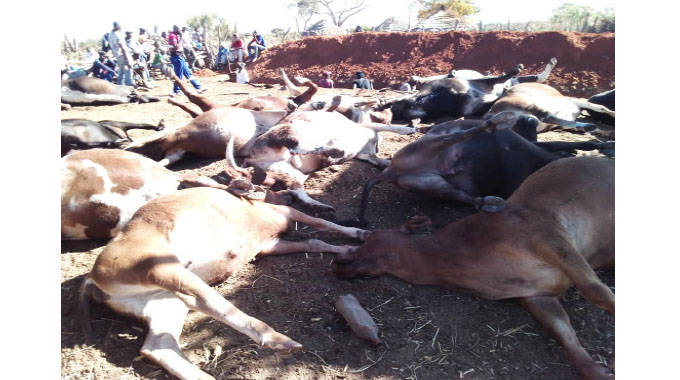Tsholotsho farmer loses 14 cattle to poisonous plant

Sikhumbuzo Moyo, Senior Reporter
A FARMER from Siyaphambili Village under Chief Gampu area in Tsholotsho District lost a herd of 14 cattle after the animals consumed Dichapetalum cymosum, a poisonous plant, also known as umkhawuzane.
Dichapetalum cymosum is a small prostrate shrub with a very extensive root system that goes up to 20 metres deep and is found in the northern parts of Southern Africa.
In Zimbabwe, it is mostly confined to the Kalahari sands of Matabeleland North and Matabeleland South provinces and parts of Mwenezi District in Masvingo.
Its toxic effects include vomiting, seizures, and an irregular heartbeat with death occurring a few hours after consumption.
The plant is known as “the poison that keeps on killing” because the toxin stays in the body after the animal dies. If a predator eats the animal, the predator gets poisoned.
The plant sprouts in late winter, before the spring rains, making it the predominant greenery during that period. Cases of poisoning are most frequent at this time as cattle are attracted to green leaves.
The owner of the cattle, Mr Elmore Ncube, said nine animals died the same day after eating the deadly plant while five succumbed to the poison the next day.
Four of the animals left behind calves.
“Cattle are a symbol of wealth in our culture and to lose 14 is quite disturbing. There was nothing I could do, but helplessly watch my cattle die because there’s no treatment for this poison,” he said.
“It is fatal to animals especially ruminants like cattle, goats, and sheep and there is no treatment for animals that would have ingested the plant.”
Ward 15 Councillor, Clr Morris Ndlovu said the plant is prevalent in the area with villagers losing their livestock every year to the poisonous plant during the onset of the rains.
Matabeleland North provincial Veterinary Officer, Dr Felistas Ndlovu urged farmers to continuously monitor their animals to prevent them from eating the poisonous plant.

Some of the poisoned cattle
She said diagnosis is based on finding the leaves of the plant in the rumen (stomach of the animal) as well as the presence of the plant in the grazing area.
“There are no confirmed treatment measures that have been developed for the treatment of umkhawuzane poisoning. Treatment often consists of helping animals to remain calm and caution should be taken to avoid pastures when the plant sprouts and produces new leaves,” said Dr Ndlovu.
“Removing all known plants from pastures may reduce the risk of exposure. Mechanical methods of removal have proven to be ineffective because of the plant’s extensive root system.”
Dr Ndlovu said wide-scale eradication by conventional control methods is labour-intensive, expensive and often impractical due to the difficulty in destroying its enormous deep root system.
“The use of herbicide after stumping the aerial parts can provide a short-lived relief. No herbicide has been known to control the plant completely. The best practice is to herd cattle in umkhawuzane-free pastures, provide supplementary feed and licks during the risky period, and assess the grazing areas during the critical times to avoid such areas,” she said.










Comments